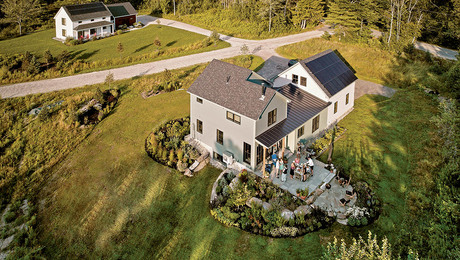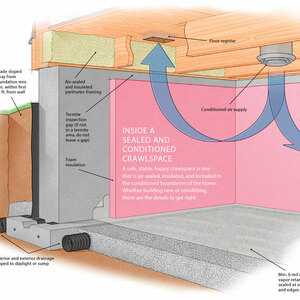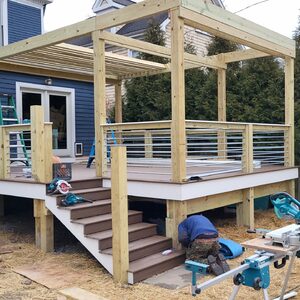I would like to know if it will be ok to use polyiso rigid insulation 4″ thick with the felt facing on both sides to insulate a cathedral ceiling. It’s a metal roof, 2×6 rafters, vented soffit and ridge vent. The cabin is located in the Sierra in California, very dry during the summer months, snow in the winter. I plan on cutting to fit between the rafters and foaming it in place leaving an air gap between the foam and roof underside.
Thanks,
Andy


















Replies
Most polyiso boards have a black colored paper facer, not felt facer, so be careful, as if it gets wet it will mold. I would use foil faced product, as it will not age as fast nor will the facer support mold. Either product should have drywall or other code approved thermal barrier on the interior.
Ted
that's the concern
Yep, that was my main concern, mold and moisture retention. The local place, Allied Building supply, called it felt faced. I'll search around for some foil faced. It will be covered on the inside.
moisture sensitive
I used the felt faced polyiso on my house recently, and I don't think it's appropriate for your project. The "felt" is fiberglass reinforced paper, and it is very sensitive to moisture. High humidity levels in the morning caused the sheets to cup dramatically, and then they would flatten out when the sun hit them.
I have a lot of fungal activity in my soil, and a piece of foam lying on the ground was quickly populated with furry white mycelium.
I used the foam behind a water barrier, and mechanically fastened it to my walls with furring strips. It was much cheaper than the foil faced options, and it worked perfectly for my project.
I would recommend that you consider EPS, XPS, or foil faced polyiso. I have read that polyiso foam absorbs the most moisture of the three main foam boards. The foil prevents that on the faces, but not on the edges. I'm not sure how you will seal the seams in the top side of the boards if your runs are longer than eight feet. I understand that you plan to use spray foam, but having sprayed a lot of foam in a can, I'm not sure how you will spray carefully enough to seal your seams while still maintaining your ventilation gap. Perhaps you have a plan for that. Using two layers of foam, with alternated seams, could probably minimize that problem.
XPS and EPS are more resistant to moisture, in my understanding and experience.
Good luck!
thanks Zimmerdale
That's what I needed to hear, some first hand knowledge. My other option is to use two layers of 2'" dow blue foam, which I can get at the Lowes nearby.
My plan for the spray foam is to first tack up some strips that will act as stops to keep the foam from being pushed in too far and then spray along the lower edge before installing the foam board.
Using the 2" will allow me to cut the foam on my table saw and stager the seams. Each rafter bay is about 10.5' long.
The blue foam by Dow is Styrofoam (the original) an XPS type. It is a good product for this application.
You can make foam board chutes on the table saw:
Rip the sheets to the rafter spacing, 16" or 24". Now set your saw blade height to 1/8" lower that your foam thickness (so 7/8" for 1" sheets). Set the guide 3/4" away from the blade, and carefully rip the same face of each strip - down one edge and back the other.
When you are done, fold those scored edges over. Now you have a rafter cute that is the EXACT width of the rafter bay and spaced continuously the thickness of the foam away from the roof deck. Use a foam gun to seal the edges.